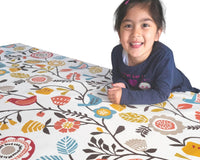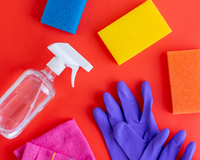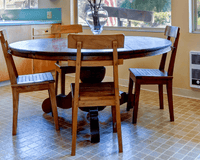Table protectors are a popular choice for safeguarding tables from spills, scratches, and heat damage. But how do they handle hot dishes, pans, or appliances? This guide combines practical advice, material science, and expert recommendations to help you use table protectors safely while maximising their lifespan. We offer a range of table protectors in all shapes and sizes, if you cannot find what you are looking for please get in touch with our friendly live chat team who can guide you.
Understanding Table Protectors' Heat Resistance
Table protectors are engineered to withstand moderate heat, but their limits depend on thickness and choice. Most protectors tolerate temperatures up to 100°C (212°F), as seen in our products at Table Protector Direct. However, direct contact with hot items (e.g., boiling pans or oven dishes) is not recommended as it will cause surface damage or may melt the protector itself.
Key Considerations:
-
Material Composition: PVC’s thermoplastic nature means it softens under high heat.
-
Heat Threshold: Avoid exceeding 100°C—use trivets or mats for added protection.
-
Surface Impact: Prolonged heat exposure can weaken the material, reducing its protective qualities.
Best Practices for Using Protectors with Hot Items
To balance convenience and safety, follow these evidence-backed tips:
-
Always Use Trivets or Heat Mats
Even though our table protectors are heat-resistant, placing a hot pan directly on the protector risks damage such as melting it. Use silicone, cork, or ceramic trivets as a barrier to protect your table protector and more importantly your table. -
Monitor Temperature Exposure
-
Avoid placing items hotter than 100°C (e.g., a just-boiled kettle) on the protector.
-
For extra caution, limit exposure to temperatures above 80°C.
-
-
Choose the Right Protector Thickness
Thicker PVC (e.g., 2.4mm–2.8mm) offers better heat dispersion. For heavy-duty use, opt for reinforced options with felt or fleece backing.
Maintenance Tips to Preserve Heat Resistance
-
Cleaning: Wipe with a soft damp cloth and antibacterial spray. Avoid abrasive cleaners that will degrade the surface.
-
Storage: Roll or lay flat to prevent creasing.
-
Flattening Curls: Use a hairdryer on low heat or place heavy objects on curled edges.
Common Myths About PVC and Heat
Myth: “PVC protectors are indestructible against heat.”
Reality: While durable, PVC has limits. Prolonged exposure to high temperatures reduces its lifespan.
Myth: “All PVC protectors are the same.”
Reality: We recommend the heavy duty table protector for premium protection of your table.
When to Replace Your PVC Protector
Signs of heat damage include:
-
Warping or permanent creases.
-
Discolouration (yellowing or scorch marks).
-
Loss of flexibility or surface cracks.
Regularly inspect your protector and replace it if damage compromises its protective function.
Expert Recommendations
-
Layer Protection: Combine a protector with a tablecloth for added safety.
-
Custom Sizing: Ensure a snug fit to minimise heat gaps. Measure your table precisely to have a table protector that fits the top perfectly. We can cut any shape or size with the bespoke options.
-
DIY Modifications: Cutting PVC to fit irregular shapes? Use sharp scissors and trace the shape out first. Or contact us and we can cut to fit most shapes and sizes.
Conclusion
Table protectors are a practical solution for heat protection when used correctly. By understanding their limitations, pairing them with trivets, and following maintenance guidelines, you can extend the life of both your protector and table. Prioritise quality materials and proper sizing to maximise performance.











